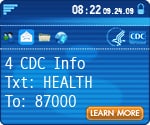You are subscribed to updates from the Centers for Disease Control and Prevention (CDC).
CDC H1N1 Flu Website Situation Update, May 14, 2010
Key Flu Indicators
Each week CDC analyzes information about influenza disease activity in the United States and publishes findings of key flu indicators in a report called FluView. During the week of May 2-May 8, 2010, nationally all key flu indicators are low. Activity levels at this time are similar to what is usually seen during the U.S. summer months. Below is a summary of the most recent key indicators:
- Visits to doctors for influenza-like illness (ILI) remained stable from last week, but are low nationally, with all 10 U.S. regions reporting ILI below region-specific baseline.
- Laboratory-confirmed hospitalizations rates have leveled off.
- The proportion of deaths attributed to pneumonia and influenza (P&I) based on the 122 Cities Report decreased over last week. No pediatric deaths were associated with flu were reported this week. Since April 2009, CDC has received reports of 338 flu laboratory-confirmed pediatric deaths: 282 due to 2009 H1N1, 53 pediatric deaths that were laboratory confirmed as influenza A, but the flu virus subtype was not determined, and three pediatric deaths that were associated with seasonal influenza viruses. (Laboratory-confirmed deaths are thought to represent an undercount of the actual number. CDC has provided estimates about the number of 2009 H1N1 cases and related hospitalizations and deaths).
- No states reported widespread or regional influenza activity. This is the fourth consecutive week that no states reported widespread or regional flu activity. Most states are reporting no activity or sporadic activity.
- The majority of the influenza viruses identified so far continue to be 2009 H1N1 influenza A viruses. These viruses remain similar to the virus chosen for the 2009 H1N1 vaccine and remain susceptible to the antiviral drugs oseltamivir and zanamivir with rare exception.
*All data are preliminary and may change as more reports are received.
U.S. Situation Update
U.S. Patient Visits Reported for Influenza-like Illness (ILI)

U.S. Influenza-like Illness (ILI) Reported by Regions

|
Date Reported
|
Laboratory-Confirmed 2009 H1N1 Influenza Pediatric Deaths
|
Laboratory-Confirmed Influenza A Subtype Unknown Pediatric Deaths
|
Laboratory-Confirmed
Seasonal Influenza |
Total |
|---|---|---|---|---|
| This Week (Week 18, May 2- May 8, 2010) | 0 | 0 | 0 | 0 |
| Since August 30, 2009 | 222 | 50 | 1 | 273 |
| Cumulative since April 26, 2009 | 282 | 53 | 3 | 338 |
|
This table is based on data reported to CDC through the Influenza-Associated Pediatric Mortality Surveillance System. Influenza-associated deaths in children (persons less than 18 years) was added as nationally notifiable condition in 2004. For more information about influenza-associated pediatric mortality, see FluView. |
||||
For more information about the U.S. situation, see the CDC H1N1 Flu U.S. Situation page.
International Situation Update
This report provides an update to the international flu situation using data collected through May 9, 2010, and reported by the World Health Organization (WHO) on May 14. WHO continues to report laboratory-confirmed 2009 H1N1 flu deaths on its Web page. These fatal cases are an under representation of the actual numbers as many deaths are never tested or recognized as influenza related.
The most active areas of 2009 H1N1 influenza transmission are in the Caribbean, Central America, and tropical regions of South America. 2009 H1N1 viruses continue to circulate at low levels in West Africa, South and Southeast Asia. The severe acute respiratory infection (SARI) rate in select Caribbean countries has increased since mid-April 2010. In certain countries of Southeast Asia and Central Africa, an increase in the co-circulation of 2009 H1N1 and seasonal influenza type B viruses has been reported. In the Northern and Southern temperate regions of the Americas, sporadic 2009 H1N1 activity continues to be observed. In Europe, the number of influenza type B detections exceeded that of influenza A, and is persisting in parts of Southern and Eastern Europe. Chile continues to report increased influenza like illness (ILI) activity associated with co-circulation of 2009 H1N1 influenza and other respiratory viruses.
For more information about the international situation, see the CDC H1N1 Flu International Situation page.
Recent Updates of Interest
- UPDATE: 2009 H1N1 Flu International Situation Update
This report provides an update to the international situation as of May 14, 2010. The World Health Organization (WHO) continues to report updated 2009 H1N1 flu-associated laboratory-confirmed cases and deaths on its Web page. - UPDATE: Weekly FluView Map and Surveillance Report for Week Ending May 8 2010
During week 18 (May 2-8, 2010), influenza activity decreased in the U.S. 26 (1.5%) specimens tested by U.S. World Health Organization (WHO) and National Respiratory and Enteric Virus Surveillance System (NREVSS) collaborating laboratories and reported to CDC/Influenza Division were positive for influenza.
Additional Updates on the CDC H1N1 Flu Website
To learn about other recent updates made to the CDC H1N1 Flu Website, please check the "What's New" page on the CDC H1N1 Flu website.
Get H1N1 Updates & Health Tips via Text Message
 Sign up to get health updates sent via text message. Messages are sent about three times a week with relevant H1N1 flu updates and timely
health tips.
Sign up to get health updates sent via text message. Messages are sent about three times a week with relevant H1N1 flu updates and timely
health tips.
Text UPDATES to 87000 to sign up.
To learn more, see www.cdc.gov/mobile.
Modify/Update Subscriber Preferences | Unsubscribe | Send Feedback | Learn more about CDC Email Updates
To receive the latest news for your region, please update your profile with your country, state and zip code.
Questions or problems? Please contact support@xxxxxxxxxxxxxxx.

|
Fight Flu with Facts! • Visit Flu.gov
|

|
Centers for Disease Control and Prevention (CDC) · 1600 Clifton Rd · Atlanta GA 30333 · 800-CDC-INFO (800-232-4636)


